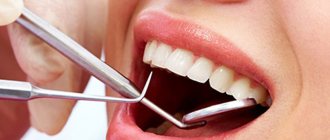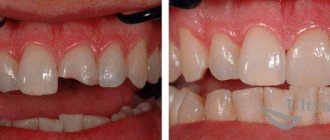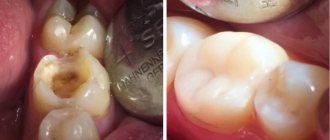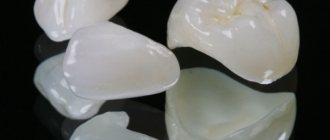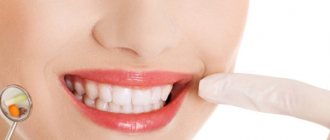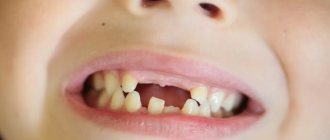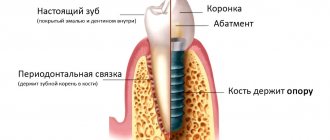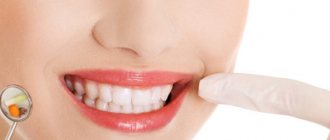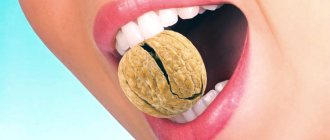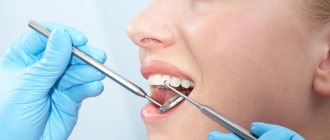Restoration of tooth enamel is a procedure that ensures the regeneration of the damaged dentin surface.
The following causes of enamel damage are identified:
- genetic predisposition;
- physiological state of the body (presence of internal diseases that negatively affect tooth enamel);
- lack of essential substances and minerals in the diet;
- anatomical features of the structure of teeth;
- excessive consumption of citrus fruits;
- brushing your teeth with a hard brush;
- eating large amounts of sweet, sour and very hot foods;
- abuse of carbonated drinks and alcohol;
- using toothpaste or abrasive powder.
Contraindications to restoring damaged tooth enamel
In fact, the procedure has no contraindications. Our task, before restoring the enamel, is to identify and eliminate the cause that leads to its damage. This could be bruxism (involuntary grinding of teeth), various malocclusions that lead to tooth wear. And often it takes many times longer to solve the problem than to restore the teeth itself. Therefore, much depends on the patient’s determination and desire to achieve an aesthetic result.
We will create an effective treatment program for any clinical case. That is, we will first cure bruxism by wearing special mouthguards, correct the bite with braces or aligners, and then begin to restore the enamel of problem teeth.
Prevention of enamel damage
In order for the enamel to be strong, it is necessary to include in the diet foods rich in calcium, fluorine, phosphorus, magnesium, iron, vitamins A, C, and group B. These are dairy products, non-starchy vegetables, herbs, fish and seafood. It is necessary to eat hard raw vegetables, such as carrots, from time to time. This is a simple way to naturally massage your gums and improve blood circulation in your mouth.
It is important to monitor your drinking regime - the amount of clean water consumed. Water is needed for the normal functioning of the salivary glands and maintaining the necessary chemical properties of saliva.
The next step is to maintain a high level of oral hygiene. In addition to a toothbrush and toothpaste, it is recommended to use dental floss, irrigator, and rinses. This is especially true for patients who wear braces and other orthodontic structures.
It is also necessary to visit the dentist once every 6–12 months, even if there are no complaints. Preventive visits allow you to save money on the treatment of caries and pulpitis.
Preparation
First, you will be examined by a doctor who will identify the problem and tell you in detail how much it costs to restore the enamel on your teeth in your particular case. Before the procedure, each patient must undergo ultrasonic teeth cleaning to remove hard deposits (tartar) from the surface. In some cases, it is this that causes darkening or yellowing. The type of restoration is selected individually depending on the indications and wishes of the patient. How much the procedure costs depends on the restoration method. Not a single dentist in the world can re-enamel teeth, but it can be restored.
Direct and indirect dental restoration
Direct and indirect dental restoration are methods of restoring hard dental tissues. The restoration is performed taking into account the anatomy, morphology and functionality of the tooth. The main differences between these methods are the material from which the future restoration will be made, the technique of execution and, as a result, strength and aesthetic appearance.
So when performing the direct method
For restorations, light-curing composite materials are used, and for
indirect
restorations, all-ceramic or all-zirconium blocks are used.
The advantages of ceramics over composites are obvious. Numerous studies have shown that ceramics are not prone to staining, abrasion, do not absorb odor and prevent the formation of plaque due to its perfectly smooth surface.
The time required for direct cosmetic restoration of teeth is a little from 1 to 2 hours, and the production time for indirect, ceramic restoration of the tooth shape is several days.
Types of restoration
Restoration with photopolymers
In case of significant damage, we use imported light-curing polymers with different hardness and particle sizes. You can thoroughly select the shade according to the VITA scale. A wide range of options allows the therapist to precisely select the material to restore enamel on the chewing or front teeth.
When working with the material, the doctor uses aesthetic restoration methods. For example, polymers with macroparticles make it possible to accurately recreate the relief of the tooth surface, down to small fissures. The restoration takes place directly in the patient's mouth: each applied layer of composite is cured with an ultraviolet lamp. The result is that the restored tooth is visually indistinguishable from its “neighbors,” and the restoration completely merges with the dental tissues.
Remineralization and fluoridation
If the enamel is weakened and needs strengthening, we treat the tooth surface with a restorative composition containing fluoride, calcium or other minerals. The medicine helps teeth better withstand an acidic environment and prevents the development of pathogenic microflora. In particular, the method is effective for highly sensitive teeth. The drug forms a thin film on the enamel, which has the functions of strengthening and protection.
Installation of veneers
If we are talking about aesthetic defects in the smile area (most often the upper incisors), we recommend installing veneers. These are thin (0.3-0.8 mm thick) ceramic plates that are firmly fixed on the outer surface of the teeth after preliminary grinding. Treatment is necessary so that the plates look natural on the teeth and do not stick out.
Veneers are permanent structures. Their advantages are durability, color retention, natural appearance. That is, your front teeth will always look well-groomed and beautiful. However, this is the most expensive method, so first consult with our doctor and find out how much it costs to restore tooth enamel in your case.
Causes of enamel destruction
The main component of enamel is fluoride. It also contains iron, calcium, aluminum, and copper. Its maximum thickness reaches 2 mm on the chewing surface of the teeth. There are a number of reasons that contribute to the destruction of enamel:
- mechanical injuries causing cracks and chips (the habit of gnawing hard objects, biting threads);
- abuse of drinks with high acid content;
- temperature changes, for example, drinking hot coffee at the same time as ice cream;
- thyroid diseases;
- Gastrointestinal diseases: gastritis, heartburn, dysfunction of the salivary glands;
- taking drugs that suppress the secretion of the salivary glands;
- long-term use of antibiotics;
- metabolic disorders;
- dental factors: bruxism (teeth grinding), abuse of the whitening procedure, caries, malocclusion;
- poor nutrition, diet deficient in vitamins and macroelements;
- smoking;
- pregnancy;
- elderly age.
The genetic factor also plays a role. The fragility of enamel, as well as dental anomalies, can be inherited.
Ceramic veneers
Ceramic veneers are thin ceramic plates that are attached with special slots-locks on the front surface of the fangs or incisors. The method allows you to eliminate gaps between teeth, slight curvature, congenital or acquired defects of the oral cavity. Veneers have a long service life (more than 10 years) and do not change their quality characteristics. Often, veneers are placed on all teeth, as they create a flawless appearance of the smile line. The installation of veneers is not a restorative procedure, as it involves even greater destruction of dental structures, as is the case with the implant method. If the patient ever decides to remove the veneers, the enamel cannot be restored using alternative methods. You will have to either re-use ceramic onlays or install crowns.
Even if you follow all the rules of daily oral care, it is not always possible to maintain the strength of the enamel. This may be due to irreversible pathological processes in the body, congenital defects, or the need to constantly take special medications. Our clinic’s specialists will help patients gain self-confidence and maintain dental health for many years.
Implantation
If the first two methods can be classified as minimally invasive methods of restoring teeth in children and adults, then implantation is a radical solution for improving enamel in adults or in children with a mature bite. The implantation method involves applying a special composition that organically resembles natural material. When applied, it reacts with the patient’s tooth enamel, activating regenerative processes at the cellular level. Artificial enamel is practically no different from natural enamel. The procedure allows you to eliminate natural yellowness, strengthen thin enamel, and create an aesthetic appearance for both a single tooth and the entire dentition. The operation is technically complex. Our clinic’s specialists will be able to carry out professional restoration even in the most difficult cases using the implantation method.
Installation of crowns
This method is used for serious defects of one or more teeth. In dentistry, crowns are products made of ceramics or metal, which, like caps, are placed on a damaged unit.
It is impossible to restore the stump or cutting edge of a tooth in this way in one session. The crown is made on the basis of an individual impression. In addition, before installing a crown, it is necessary to sanitize the teeth. The price of the service will depend on the chosen material, the complexity of the restoration and other points.
Whatever method is chosen, the success of the result will depend both on the quality of the materials used and the professionalism of the dentists.
Dr. Razumenko’s dental clinic in Moscow employs not just highly qualified dentists, but professionals with extensive experience who restore teeth using modern computer technology, the latest precision equipment and proven materials. The careful and high-quality work of our specialists will not only restore your teeth, but also make them even more beautiful and stronger.
Dentists on Rimskaya
Gneusheva Elena Viktorovna
Dentist-orthodontist, pediatric orthodontist
Experience: 20 years
★ For more than 13 years she worked at the Moscow State Medical University at the Department of Orthodontics and Children's Prosthetics, Ph.D.
Gorokhova Inga Vitalievna
Dentist-therapist
Experience: 14 years of total experience
★ Expertise in restorative dentistry to make your teeth shine
Konstantinov Oleg Nikolaevich
Dental surgeon
Experience: 25 years
★ Virtuoso of painless treatment. Patients fall asleep in the doctor's chair
Nikolaychuk Anna Vladimirovna
Chief physician, dentist-therapist
Experience: 13 years
★ Chief specialist in the treatment of toothache. Masterfully deals with problems quickly and permanently
Frolova Alexandra Ivanovna
Dentist-therapist
Experience: 25 years
★ A brilliant specialist with many years of experience as a manager in public dentistry
Restoration of enamel using photopolymer fillings
The destruction of tooth enamel to the dentin level no longer requires any preventive measures. Since hard tissues do not repair themselves, more radical methods must be used. The intensive development of technologies for the manufacture of polymer materials has led to the fact that dentistry today is able to replace a damaged crown, completely preserving the functions and aesthetic properties of a natural tooth. Light-curing fillings are flexible and allow the dentist to model a dental crown for as long as necessary. Hardening of the filling occurs only when it is exposed to ultraviolet rays. Latest generation fillings:
- durable (shelf life up to 10 years);
- abrasion resistant;
- biologically completely compatible with oral tissues;
- indistinguishable from the natural tissues of the dental crown.
Restoration is possible not only in case of crown caries or abrasion of tooth enamel, but also in case of mechanical damage to hard tissues, chipping and crushing of the crown from a blow from a hard object, etc. Most often, such restoration is required for the front teeth. The aesthetic component of such restoration is at the highest level today. Filling materials look so natural that even dentists themselves cannot always find the line between the natural crown tissue and the light polymer. Only years later can this edge appear in the form of a thin strip on the enamel.
Basic principles for selecting a reconstruction method
- If tooth decay is insignificant and you do not want to pay a high price, composite materials are suitable.
- In case of serious tooth decay, you need a strong, reliable, albeit expensive design - a ceramic veneer or inlay.
- Serious destruction of the crown, but there is no room for a veneer or a cheaper option is needed - these are pin options.
- You need to restore one or more teeth permanently, efficiently and as aesthetically as possible - an implant will help.
- Fixed bridge prosthesis - this option is used to fill the space from the absence of one tooth.
The doctor at the clinic will suggest a specific solution to the problem after the examination. The patient needs to be informed about his habits and wishes, since this determines which method is suitable for the person.
Fluoridation of teeth
To restore tooth enamel, you can use the fluoridation method. It refers to the saturation of the tooth surface with fluoride-containing preparations. The procedure is performed on the primary or permanent dentition. The effect of fluoride on enamel has the following advantages:
- increasing the service life of artificial orthodontic structures;
- increasing resistance to aggressive external agents;
- reducing excessive enamel sensitivity;
- prevention of caries.
Fluoridation strengthens enamel and is considered an effective method in the fight against its destruction. Before the procedure, hygienic cleaning and removal of plaque and stones, if any, are carried out. Fluoridation is classified into two types:
- simple (applying fluoride varnish or special preparations to orthodontic aligners);
- deep (saturation of the external and internal structure of the tooth with fluorine and calcium).
Fluoridation of teeth is widely used in children to strengthen thin enamel. The main contraindications include any allergic reactions to dental composites or active substances in applications, gels, restorative emulsions, the presence of endemic mottling of teeth, and excessive concentrations of fluoride in water.
Pathologies and diseases of tooth enamel
The protective shell must withstand the negative effects of sweet and sour foods and drinks every day. But this is not the only reason for the occurrence of pathologies and diseases. If tooth enamel becomes thinner and hurts, then the following factors could provoke it:
- the presence of bad habits (this includes, for example, smoking, constant picking of metal objects in the mouth, excessive passion for seeds);
- bruxism (grinding during sleep);
- unprofessional bleaching;
- taking certain medications (for example, the widely used aspirin);
- insufficient level of hygiene;
- impaired metabolism or alkaline balance of saliva;
- malocclusion (due to uneven distribution of load on the dentition);
- poor-quality prosthetics (crowns are hard, so when talking or chewing they can severely damage the enamel layer).
Also, don't discount genetics. If parents have a too thin and weak enamel layer, then with a high degree of probability their children will encounter the same problem.
You can notice the thinning and abrasion of tooth enamel by the following signs:
- Increased sensitivity to hot and cold.
- The appearance of cracks and defects. Therefore, if a stain is found on the enamel of a tooth , you should not hesitate to visit the dentist.
- Color change.
- Dullness after regular brushing or if you have undergone a procedure such as ultrasonic teeth cleaning.
In the first stages there is no pain. Since the wearing off of the protective layer occurs slowly and is not always noticeable to the person himself, it is important to regularly visit the dentist for preventive measures.
If there is a problem, the doctor will make a diagnosis and prescribe treatment. Erosion of tooth enamel is diagnosed very often. As a rule, the first signs of pathology appear on the convex surface in the form of oval or round defects. Subsequently, the shell wears off, resulting in dentin damage. This leads to injury to the oral mucosa, inflammatory processes in the gums, blackening and destruction of dental plates, and infection in the bone tissue.
Dark tooth enamel is not always a sign of a thinning protective shell. Darkening can be caused by caries, serious systemic pathologies of the body, abuse of coffee and tea, age factor, injuries and other reasons.
There is also such a pathology as tooth enamel hypoplasia . This is a congenital non-carious lesion of the dentition due to metabolic disorders during the period of intrauterine development.
Ways to Use Dental Composite
When restoring a tooth with a composite, two methods of using the material are used:
- direct composites (placed by a specialist in a clinical setting). Polymerization is achieved through a manually held laser. Such composites are suitable for filling cavities or small gaps between teeth, minor changes in units - aesthetic restoration of teeth;
- indirect composites (become hard outside the oral cavity - in special devices).
CONCLUSION
The two-opaque restoration technique using only two shades of transparency: the more opaque dentin (Dentin) and the more transparent enamel (Enamel) nanocomposite material Filtek® Ultimate - allows you to create esthetic direct restorations of anterior teeth, characterized by saturation, brightness, color transparency and opalescence.
Good aesthetic results are achieved thanks to the ability to build the internal structure of the tooth crown, which, in turn, imitates the color of a natural tooth. The aesthetics are enhanced by the improved polishability and durability of the dry sheen of the composite. This approach allows you to recreate the natural beauty of the tooth and satisfy the aesthetic requirements of the patient.
https://dentalmagazine.ru/
Indications and contraindications
Indications
:
The goals of the procedure are to restore the color, shape, and functionality of the tooth. Restoration eliminates crown chips, cracks and irregularities, fragments of destroyed tissue, damage/thinning of enamel, manifestations of a wedge-shaped defect, caries:
- correction of aesthetic indicators;
- treatment of lesions and inflammations of non-carious/carious origin with complete regeneration of the organ’s performance indicators: production of an artificial unit/bridge in the laboratory, filling of carious cavities.
Contraindications
:
The intervention is not performed if you have a pacemaker, are allergic to restoration materials, or are unable to fully isolate the tooth or oral cavity from moisture. If a patient is diagnosed with severe symptoms of bruxism, pathological bite, or increased abrasion, a preliminary consultation with a neurologist, psychologist, or dental therapist is required.
Bone augmentation
If the bone tissue thickness is insufficient, the patient undergoes bone augmentation as part of orthopedic treatment and implantation. If the bone layer is very thin, the titanium pin will not take root – the specialist will not be able to install the product.
Bone grafting comes to the rescue, involving the use of natural and synthetic materials.
Another option for restoring the front or chewing teeth is the implantation of a plate, which is placed over the bone and covered with mucous membrane.
Pin restoration
If the crown of the tooth is severely damaged and its root is also damaged, then the pin method can help. This method allows, in case of severe destruction of a front tooth or molar, to restore and return it to its previous shape by extending its crown onto a pin.
Pins are used not only to restore a tooth and correct a bite, but also to be able to attach a prosthesis or crown to the root. The pin method is even equated to artistic restoration.
Inexpensive, durable pins are made from an alloy of chromium and cobalt. Their disadvantage is that the patient may be allergic to these materials. A metal pin is not placed on the front teeth due to the risk of translucency. For teeth in the smile zone, a ceramic or fiberglass design is used. The method is significantly lower in price compared to other options.
Microprosthetics with inlays
Modern dentistry, instead of conventional tooth filling, offers the option of restoring teeth using microprosthetics with inlays. This method allows you to restore and preserve a large part of the tooth.
Inlays for microprosthetics are made from various materials - ceramics, zirconium, gold or cobalt-chrome.
It is worth noting that the inlays last an order of magnitude longer than conventional fillings due to their denser structure than that of filling materials and the tightest fit of the inlays to the tooth tissue. The latter quality allows you to avoid the risk of recurrent caries and inflammatory processes.
During microprosthetics, a ready-made inlay (microinsert) is installed in the cavity of a living tooth, which will ensure the restoration of the coronal part, even if no more than a third of it remains.
Restoration with photopolymers (composite materials)
Photopolymers
– these are light-curing liquid composite materials, which consist of an organic matrix and filler, hardening under the influence of ultraviolet radiation. The quality of these materials will depend on the size and amount of filler used. For example, to restore the integrity of a tooth, hybrid composites with small particles are used, and large ones are used for filling.
Effective restoration of tooth enamel using photopolymer materials is one of the most reliable and aesthetic areas in dentistry today. Using photopolymers, you can either install a high-quality filling on a tooth, cure caries, or, if part of a tooth is missing, restore its shape to its original state. But modeling with photopolymers is only possible in the presence of tooth tissue.
Photopolymers are used if it is necessary to restore
:
- size, shape or color of the tooth;
- tooth enamel darkening;
- the entire crown, but only the root remains;
- tooth if chips or cracks occur.
Photopolymers are also used for tooth mobility or if there is a need to straighten the dentition.
Photopolymer filling (or as it is also called light filling) is not only very durable, but also has excellent aesthetic qualities. This type of composite reproduces the shape of the crown, and the filling can be given the desired natural color.
